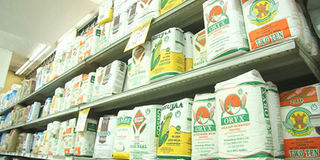We need smart policies to give maize a long, prosperous future

Different varieties of maize flour sold at a supermarket. As supplies dwindle, commodity prices are again rising. Millers have raised retail prices. PHOTO | FILE | NATION MEDIA GROUP
What you need to know:
- Kenya has had to deal with the classic food-price dilemma of keeping prices high enough to make sure farmers can profit yet low enough so that consumers can buy affordable food.
- Co-operatives also provide opportunities for diversification into irrigation, high-value export crop production such as coffee and fruits. They are a good focal point for training and extension services.
If we didn’t have maize, everything would be different, from how we farm to what we eat.
Less than one season ago, it seemed we were growing more maize than the country could handle.
Today, faced with stark realities of catastrophic drought, the country must brace for a looming food shortage, amid rising prices of the staple commodity — maize.
Yet the most amazing fact about maize production in Kenya may be that this crop was not grown in Kenya until just about a century ago — and today our country relies on it like no other.
British colonists brought maize to Kenya at the start of the 20th century, and for many years most of what they grew was exported.
None was eaten domestically. That changed as colonial policies required Africans to work on British settler farms and receive rations of white maize as “in-kind” payments for their labour.
TECHNOLOGY
By 1925, Kenyans were moving away from a traditional diet dominated by millets, tubers, and legumes and eating more maize.
The introduction of hammer mills boosted consumption further as this meant maize was milled faster and cheaper than the millet and sorghum.
By the late 1930s and early 1940s, African farmers competed with British colonial farmers in the production of maize and the government introduced marketing boards to regulate marketing of the crop, paving the way for state-controlled crop buying and large-scale milling.
In the 1950s, these boards began to use roller-mill technology that produced a refined, expensive meal and monopolised sales to urban consumers, resulting in higher prices for farmers, killing the export market and encouraging expanded production.
This required scientific seed production, leading to the first maize research programme instituted in Kitale in 1955. The Kenya Seed began production the following year.
SHORTAGE
After Kenya’s independence in 1963, African farmers bought out the white settler farms in droves. In 1964, a hybrid maize seed was released.
The uptake of large-scale production of the crop and the continued research and development of new seed varieties led to rising production, and by the 1980s maize had become Kenya’s most important crop.
The market liberalisation of the 1990s brought new challenges. The government stopped buying the crop, opening the door for private-miller dictated prices.
Maize production failed to keep up with Kenya’s booming population, realising high and low years of production, even though breeders and agronomists exploited its genetic potential and the government stepped in with farmer-friendly policies aimed at increased production.
Yet just two years ago, Kenya faced a genuine maize shortage — and the government declared an emergency.
CHALLENGES
In the traditional breadbasket counties of the North Rift, farmers responded by growing more maize.
Meanwhile, government-sanctioned importation gave room to cartels to sell substantial quantities of maize to the National Cereals and Produce Board (NCPB), misrepresented as “maize from Kenyan farmers”, ultimately flooding the market and receiving all the money set aside for farmers.
Today, as the drought bites into the current planting season, farmers are still holding on to more than two-thirds (about 21 million bags) of last year’s production.
The problem will only worsen as we face a new conundrum brought about by climate change, high costs of production, price instability, foreign competition, pests and diseases, monocultural production practices, and poor marketing strategies.
As supplies dwindle, commodity prices are again rising. Millers have raised retail prices.
COOPERATIVES
The temporary benefit of more affordable food is passing us by, and we’ll all pay a long-term price as farmers will not produce anything this season.
As happens too often, our agricultural sector suffers from underproduction and our people succumb to hunger, malnutrition, or worse.
Kenya has had to deal with the classic food-price dilemma of keeping prices high enough to make sure farmers can profit yet low enough so that consumers can buy affordable food.
There are no simple solutions to this problem. National and county government leaders have proposed several solutions, including irrigated production.
One of the best ideas is for the government to empower farmers’ co-operatives. These organisations can organise early acquisition of farm inputs and serve as avenues for value addition and diversification, helping farmers gain better access to markets.
POLICIES
Uasin Gishu Governor Jackson Mandago has spearheaded the formation of co-operative-owned maize milling plants, owned by co-operative members, with logistical and financial support from the county government.
Finally, co-operatives also provide opportunities for diversification into irrigation, high-value export crop production such as coffee and fruits. They are a good focal point for training and extension services.
Maize may have a relatively short history in Kenya, but smart policies will give it a long and prosperous future.
The writer is a small-scale farmer and lecturer of marketing and management at Catholic University of Eastern Africa, Eldoret campus. He is also a member of the board of directors of Kenya Fish Marketing Authority.




